





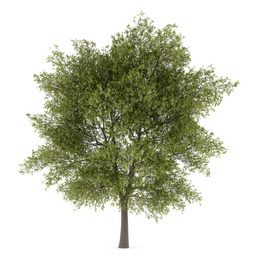 A poplar tree symbolizes great strength, endurance and conquest. The poplar trees are of the populus genus and belong to the salicaceae family. The genus includes the balsam poplar (Populus balsamifera), aspen or the white poplar (Populus alba), the gray poplar (Populus canescens), the black poplar (Populus nigra), and the cottonwood (Populus deltoides). Many a time, people misidentify the yellow poplar tree (tulip poplar tree) as the white poplar tree, but actually the yellow poplar does not really belong to the poplar family.
A poplar tree symbolizes great strength, endurance and conquest. The poplar trees are of the populus genus and belong to the salicaceae family. The genus includes the balsam poplar (Populus balsamifera), aspen or the white poplar (Populus alba), the gray poplar (Populus canescens), the black poplar (Populus nigra), and the cottonwood (Populus deltoides). Many a time, people misidentify the yellow poplar tree (tulip poplar tree) as the white poplar tree, but actually the yellow poplar does not really belong to the poplar family. 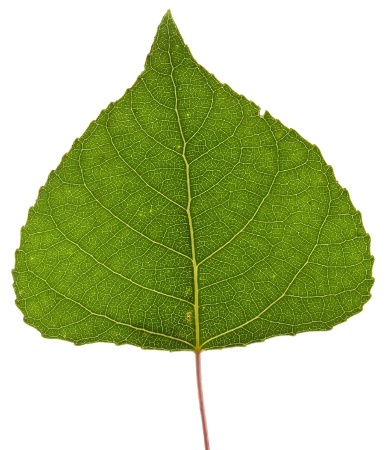 The leaves of this tree are egg-shaped and thick. They are dark green above and pale green beneath. The tip of the leaf is pointed and edges are finely toothed. There is a whitish waxy coating on the underside of the leaf. These trees are also identified by the pleasant balsam scent of the opening buds. The unique scent is also how the tree derives its name the balsam poplar tree. These trees need a lot of sunlight, to be able to retain the considerable amount of moisture, but they can tolerate very cold climatic conditions as well. The balsam poplar is a native of the eastern and northern areas of the United States.
The leaves of this tree are egg-shaped and thick. They are dark green above and pale green beneath. The tip of the leaf is pointed and edges are finely toothed. There is a whitish waxy coating on the underside of the leaf. These trees are also identified by the pleasant balsam scent of the opening buds. The unique scent is also how the tree derives its name the balsam poplar tree. These trees need a lot of sunlight, to be able to retain the considerable amount of moisture, but they can tolerate very cold climatic conditions as well. The balsam poplar is a native of the eastern and northern areas of the United States.
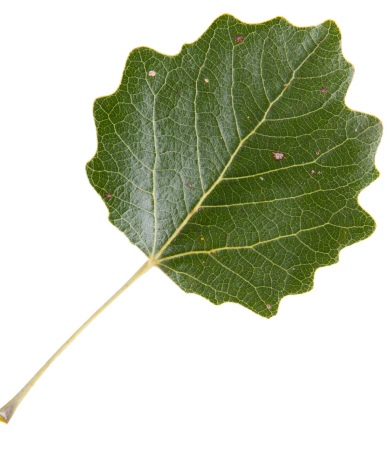 This tree is also called the Silver poplar, Silver-leaf poplar and Abele. The leaves of this tree are oval to five-lobed in shape and wavy at the edges. They have a shiny dark green color on their upper side and a dense white color below. This white coating stays until autumn, when the tree sheds its leaves, hence the name white poplar tree. The trunk of the white poplar tree has grayish-white diamond-shaped marks on a young tree, which turn black as the tree grows old. These are some of the distinguishing features of the white poplar tree. The white poplar is a native of Spain and Morocco.
This tree is also called the Silver poplar, Silver-leaf poplar and Abele. The leaves of this tree are oval to five-lobed in shape and wavy at the edges. They have a shiny dark green color on their upper side and a dense white color below. This white coating stays until autumn, when the tree sheds its leaves, hence the name white poplar tree. The trunk of the white poplar tree has grayish-white diamond-shaped marks on a young tree, which turn black as the tree grows old. These are some of the distinguishing features of the white poplar tree. The white poplar is a native of Spain and Morocco.
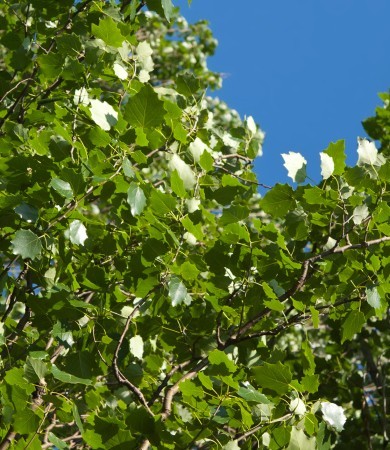 The leaves of this tree are roundish triangular-shaped with a point at the apex and have woolly grayish undersides. That's how the tree gets its name the gray poplar tree. The margins of the leaves of this poplar tree are coarse and irregularly toothed. It is one of the fastest growing trees marked with a lot of vigor, reaching a height of 40 meters, and the truck of the tree measuring 1.5 meters. It is native to the Europe and not the US, but has been introduced and naturalized everywhere now.
The leaves of this tree are roundish triangular-shaped with a point at the apex and have woolly grayish undersides. That's how the tree gets its name the gray poplar tree. The margins of the leaves of this poplar tree are coarse and irregularly toothed. It is one of the fastest growing trees marked with a lot of vigor, reaching a height of 40 meters, and the truck of the tree measuring 1.5 meters. It is native to the Europe and not the US, but has been introduced and naturalized everywhere now.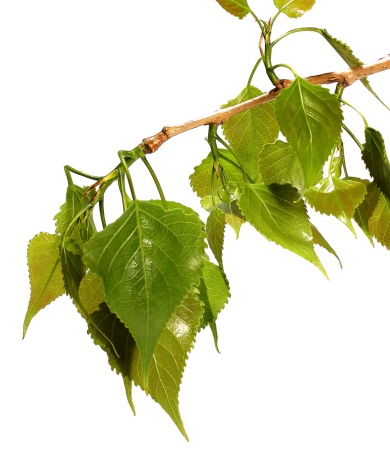 This tree has diamond-shaped or triangular-shaped leaves. They are green on both sides and coarse at the edges. The leaf veins and shoots are finely covered with soft hair. The bark of the tree is grayish brown which appears blackish, and so the name the black poplar tree. This tree is native to Europe. They have clusters of erect branches which often appear as a single column, and look absolutely beautiful.
This tree has diamond-shaped or triangular-shaped leaves. They are green on both sides and coarse at the edges. The leaf veins and shoots are finely covered with soft hair. The bark of the tree is grayish brown which appears blackish, and so the name the black poplar tree. This tree is native to Europe. They have clusters of erect branches which often appear as a single column, and look absolutely beautiful.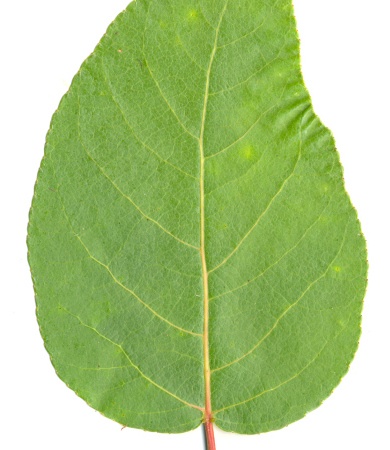 This is one of the largest North American hardwood trees. They have deltoid (triangular) broad base leaves. The edges are coarse and curved, the petiole is flat and the apex is pointed. These leaves are dark green in summer and turn yellow in the fall. The stem of the leaf is flat and so, even the slightest breeze can cause its foliage to rustle. This is one of the major characteristics of this cottonwood tree. They are the tallest broad-leaf trees that grow over 100 feet, but have short life spans like all poplars.
This is one of the largest North American hardwood trees. They have deltoid (triangular) broad base leaves. The edges are coarse and curved, the petiole is flat and the apex is pointed. These leaves are dark green in summer and turn yellow in the fall. The stem of the leaf is flat and so, even the slightest breeze can cause its foliage to rustle. This is one of the major characteristics of this cottonwood tree. They are the tallest broad-leaf trees that grow over 100 feet, but have short life spans like all poplars.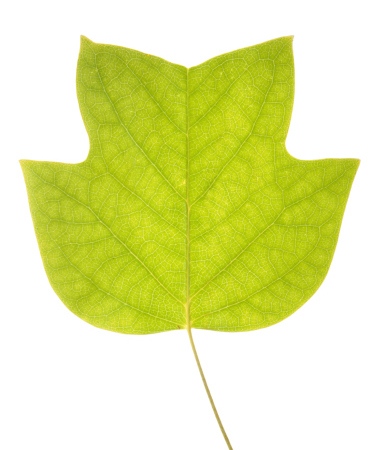 To start with, the yellow poplar does not belong to the poplar family, nor does it share any relation with the tulip flower. It is so named due its greenish-yellow hardwood and attractive tulip-like flowers. The yellow poplar is also known as the tulip tree, tulip poplar tree or yellow poplar tree. The leaves of this tree are easily recognizable as they have four large lobes often flattened into a square at the end, the apex cut across at shoal angle and have primary prominent veins. The leaves have a smooth and shiny bright green coating, but in autumn, the tree wears a bright yellow color and stands out among the green-colored leaves of the other trees, hence, making it easy to identify the tree. The other distinguishing factor being the tulip shaped flowers; yellowish-green in color with orange bands near the base. This tree is one of the largest native trees found in the United States.
To start with, the yellow poplar does not belong to the poplar family, nor does it share any relation with the tulip flower. It is so named due its greenish-yellow hardwood and attractive tulip-like flowers. The yellow poplar is also known as the tulip tree, tulip poplar tree or yellow poplar tree. The leaves of this tree are easily recognizable as they have four large lobes often flattened into a square at the end, the apex cut across at shoal angle and have primary prominent veins. The leaves have a smooth and shiny bright green coating, but in autumn, the tree wears a bright yellow color and stands out among the green-colored leaves of the other trees, hence, making it easy to identify the tree. The other distinguishing factor being the tulip shaped flowers; yellowish-green in color with orange bands near the base. This tree is one of the largest native trees found in the United States.Copyright © www.100flowers.win Botanic Garden All Rights Reserved